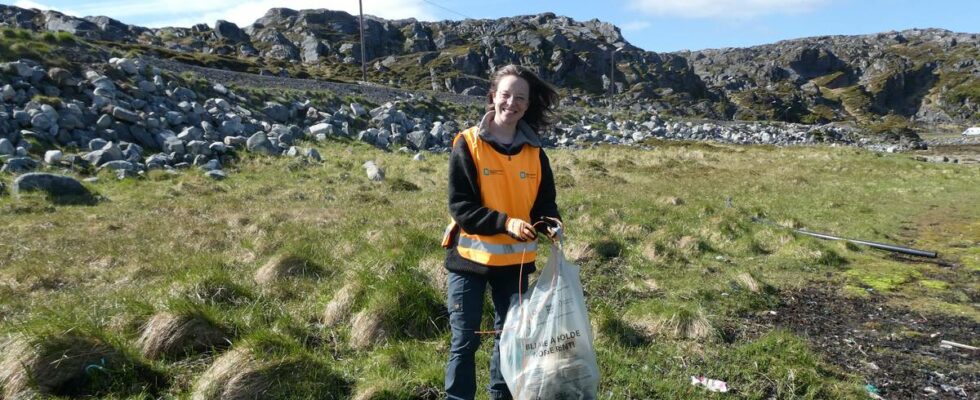– We see that the same beaches that were cleaned last year have unfortunately had a lot of marine waste added to them this year, says Christina Koch, who is project manager for Vårt Hav in Troms and Finnmark. This summer, Vårt Hav had 35 young people on duty to clean beaches in Hammerfest, Tromsø, Senja and Harstad. Fishing nets are a regular feature when cleaning the shoreline of rubbish. Photo: Vårt hav On some of the beaches this year they have found more rubbish than they found and picked up in the same area last year. – Much of the marine waste lies on the seabed and enters the beaches through winter storms. We have had many storms recently, so we see a connection, says Koch. So far this summer, the young people have managed to remove 1299.95 kg of marine waste. In Hammerfest alone, they removed 346.8 kg in the last week alone. A project with a summer job for young people, Environmental Guide, was started to show the next generation that it is important to take care of the sea and nature and that cleaning is useful. Photo: Vårt hav Koch’s experience is that efforts along the entire Norwegian coast have ensured that littering has been greatly reduced in several places, but there are exceptions. In Troms and Finnmark, the beach cleaners have seen no reduction in the amount of litter. Marine litter A recent research report from the Norwegian Environment Agency shows enormous amounts of litter and microplastics in the Barents Sea. Plastic can have disastrous consequences for seabirds and other wildlife. An opened stomach of a seahorse cub. Photo: France Collard, NIVA Previously, researchers have found over 400 pieces of plastic in the stomach of a young seahorse on Svalbard. Over a third of the birds examined had more than 100 pieces of plastic in their stomachs. – The longer such plastic rubbish is left on the shore, the more it breaks down into small pieces and microplastics which can then be spread back into the sea. That is why it is important to focus on clean-up, says Koch in Vårt Hav. This is microplastic Photo: Pandora Film The plastic that ends up in nature does not break down, but is instead broken up into smaller and smaller pieces. In the end, it turns into what we call microplastic, which is almost impossible to remove from nature. Microplastics are small particles of plastic that have a size between 0.001 and 5 millimeters. These pieces of plastic vary greatly in size, color and shape and have different properties and content of chemicals. Today we find microplastics on all continents of the world, and it is in the food we eat, the water we drink and the air we breathe. Microplastics in nature disrupt our ecosystems, and can be harmful to both humans and animals. Source: WWF More measures are required Although beaches along the coast are almost overflowing with rubbish, and researchers are uncovering enormous amounts of space in the sea, money for cleaning up has nevertheless been cut in recent years. In 2021, NOK 70 million was allocated for measures against marine litter. This year, NOK 27 million was allocated in the state budget. Ola Elvestuen (V) criticizes the government for having reduced the funds for beach cleaning by almost two-thirds in a few years. – The government is doing far too little here, and they do not have this high enough on their agenda, says Elvestuen. Storting representative Ola Elvestuen from the Liberal Party believes that the government is doing far too little to prevent marine litter. Photo: Stian Lysberg Solum He proposes several measures that the government can implement. Among other things, better waste management in Norwegian ports, a ban on single-use plastics and that much more money must be invested in clean-up. – There is never one measure that is sufficient, but the sum of the measures we manage to put in place means that we can bring about a change, says Elvestuen. Requires international cooperation Climate and Environment Minister Andreas Bjelland Eriksen (Ap) says that they are working on new rules to prevent marine litter. Photo: William Jobling / news – There is no doubt that we have a big job to do in the coming years, says Climate and Environment Minister Andreas Bjelland Eriksen (Ap). However, he rejects the criticism from Elvestuen that less money is spent on beach cleaning. – Now this plastic quota has been increased again. This means that we get more money through Handelens Miljøfond to clean up our beaches. He also says that as recently as last October, the government introduced stricter rules for the reception of waste in the ports, in order to stimulate more delivery of rubbish. – We are also working on new rules, and according to the plan we will send a proposal for a producer responsibility scheme for equipment in fisheries and aquaculture in the autumn, says Eriksen. The scheme means that whoever produces and imports packaging must take responsibility for the packaging throughout its entire life cycle. This is also a measure Ola Elvestuen is calling for. Bjelland Eriksen also says that the government is trying to get an international agreement to reduce littering in the sea. – At national level it is easier to implement measures, but to achieve lasting results we must also get the rest of the world to reduce their plastic consumption and improve waste management. – If we don’t manage to do that, we won’t be successful at home either, says the minister. Published 17.08.2024, at 16.56
ttn-69
Money for beach cleaning sharply cut in a few years – news Troms and Finnmark

